Tamiya 1/24 Kremer 935 K4
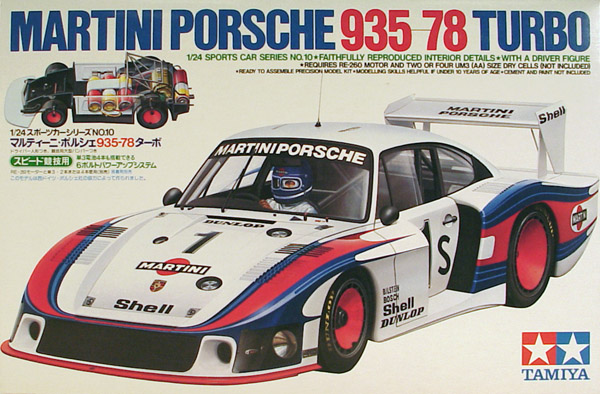
| These pages describe the work I'm performing on a Tamiya 1/24 Porsche 935-78, converting it into a Kremer 935 K4. It's my first extensive car body modification, so I might trip here and there :-)
|
From 935-78 to 935 K4
I bought the Tamiya 935-78 without a real plan what to do with it. Although it is a hugely impressive race car, I did not like the rounded smooth lines much, and neither did it look aggressive with its long low tail. Also, I had seen enough cars with Martini striping, and the 935-78's type of 'flaming' stripes did not appeal to me at all. I knew there was a possibility to build the Momo-sponsered Joest replica, using Fred Cady decals. Decals for the Joest replica 935-78 raced by Fitzpatrick in JDavid colors are also reported to exist. The next option would be to modify the model into one of the more radical redesigned replicas. After a long study of all the replicas, I decided to go for the Kremer 935 K4 in Jägermeister colors. It was going to be an extensive conversion for sure, I guess that some 50% of the bodywork would need to be rebuilt. But the real car looked just too good, and its angular looks make it much more aggressive than the 935-78. The decal problem is something for later. One word of warning: I'm no super-tidy Japanese modeler! What you see below is rather rough cutting, puttying and sanding work. Most of the modifications are done iteratively, because I don't exactly know what shape things should have. Only when I think the correct shape has been achieved, it will be tidied up. I am looking forward to those first layers of primer!
References
A first attempt at listing useful references:
- Auto Hebdo (French autosport magazine) issue #273 (approximately 2 July 1981), with four nice and very useful K4 photos of the Nurnberg race held on 28 June 1981
Construction - door repair
| Amazingly, Tamiya moulded the body with only partial doors, as you can see here. I glued a curved backing plate against the inside of the door, to create a basis for the extension forward.
| 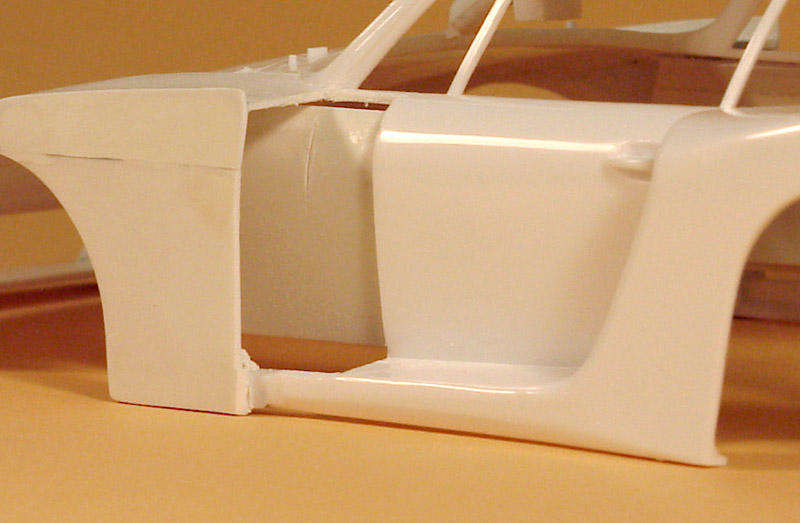
|
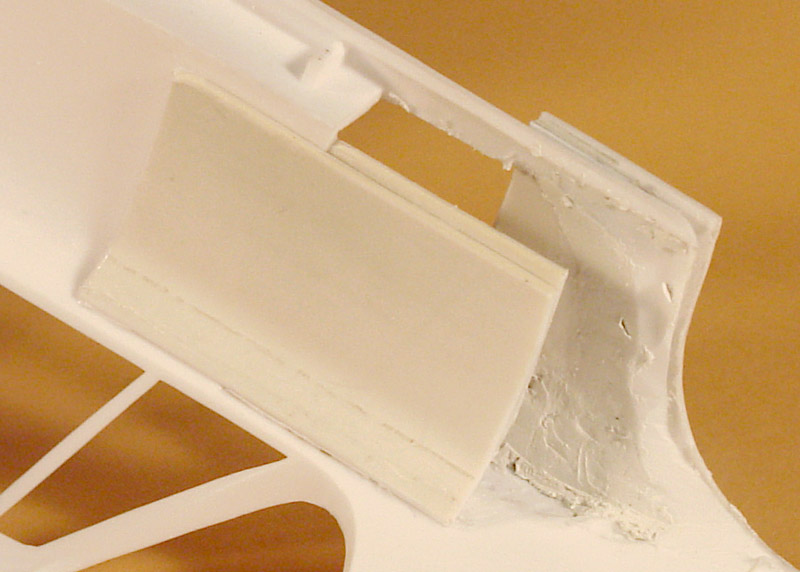
| Next was a 1 mm thick piece of card to make the outer door contour (see next photo). I measured the length on a Tamiya 1/12 935, and came up with an 18.5 mm extension. With this extension it still fits over the Tamiya chassis (tightly though).
|
| To widen the front fender, I glued card to the sides and the top of the original fender, then applied Milliput, and lastly removed most of the old fender. For the other side I changed this order, because hacking out the original fender was rather difficult. Note the small spacer glued on the side of the original running board. The 'exhaust area' is considerably larger than on the original 935-78.
| 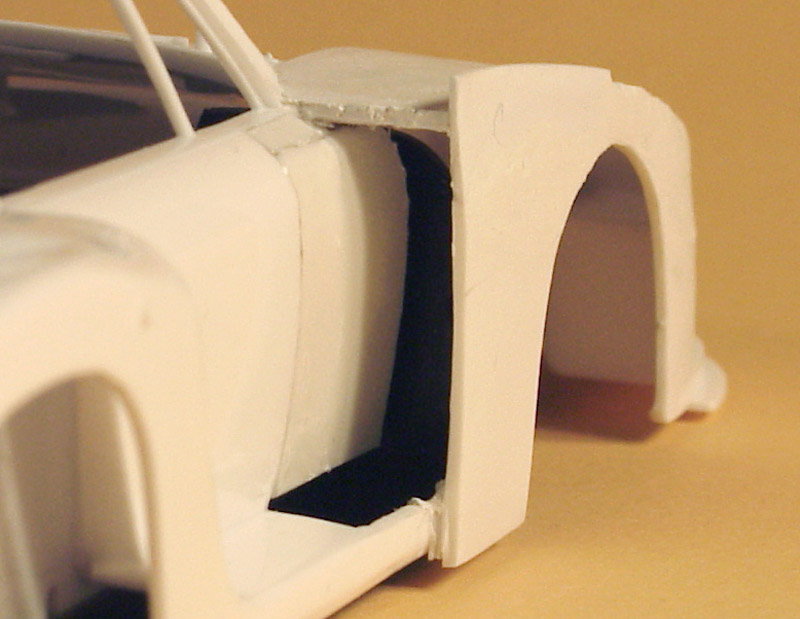
|
Construction - front fender shape
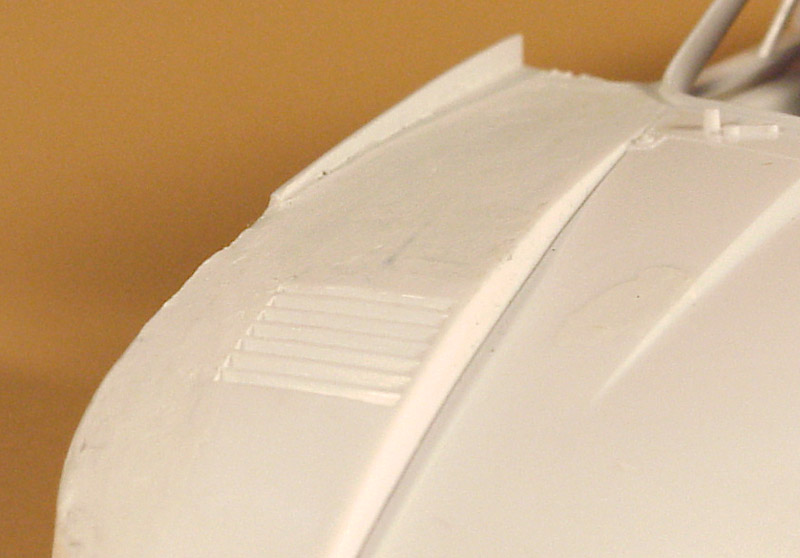
| The 'fin' or 'strake' of the fender is made from card. Lots of Milliput was used to give the front end of the fender a square shape. The rear louvres of the front fender were filled.
|
| A front top view showing the differences between the modified (left) and original fenders (right). Also visible is the length difference at the rear of the front fenders. The 935-78 headlight covers haven't been tackled so far.
| 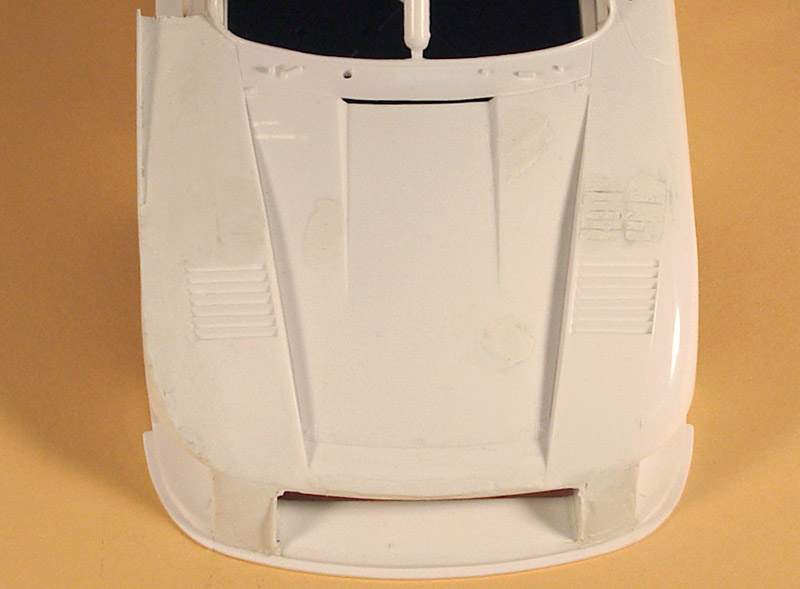
|
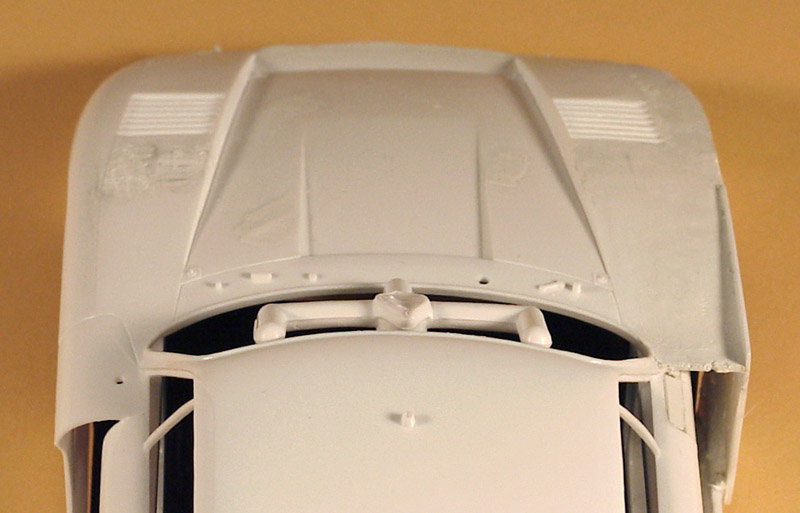
| A rear view that shows the length differences of the front fenders better, with the modified fender on the right and original the original fender on the left.
|
| Later the left fender was modified too. Here most of the fender was cut away before the new fender sides were glued on, saving lots of cumbersome sanding later.
| 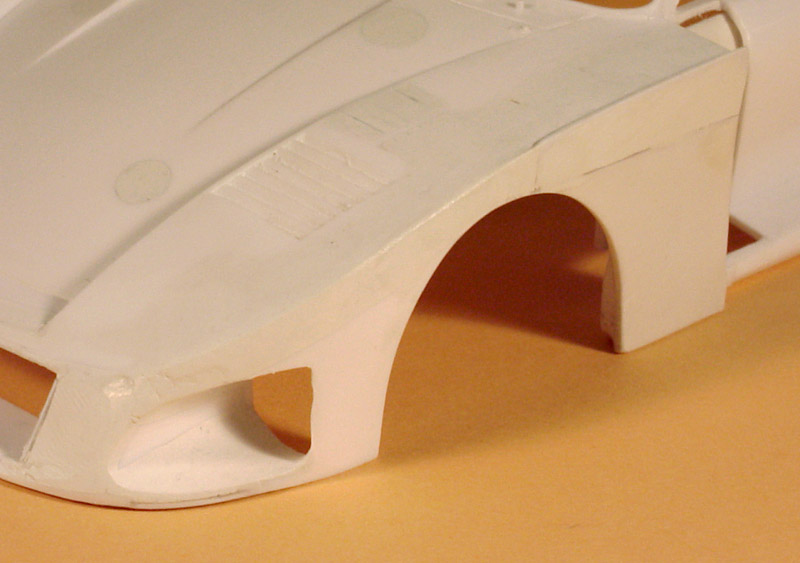
|
Construction - air intake and splitter
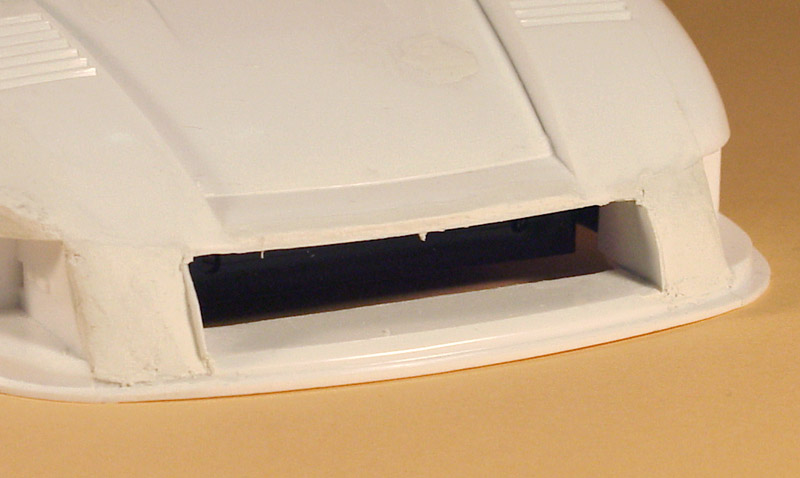
| The air intake was widened by sanding, after which pieces of card were glued to the inside to make smooth surfaces. Looking back, the kit's air intake appears to have been asymmetric, but I don't have a second model to check it.
|
| The view from the inside shows Milliput around the air intake. This was added before the sanding started. Also visible is the shortened lip to bring the radiator more forward.
| 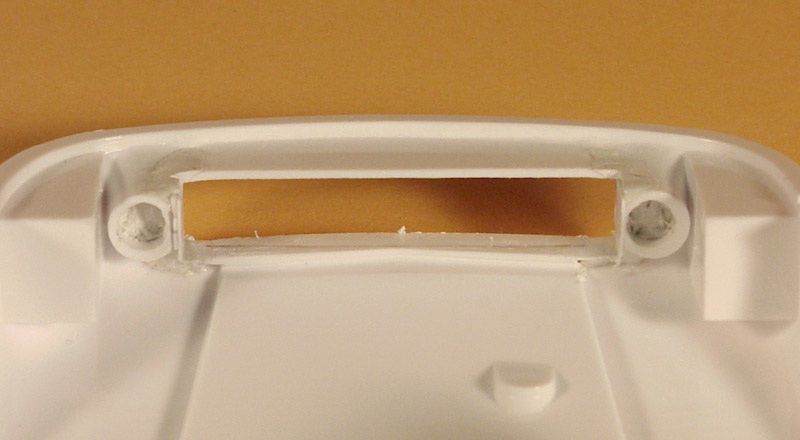
|
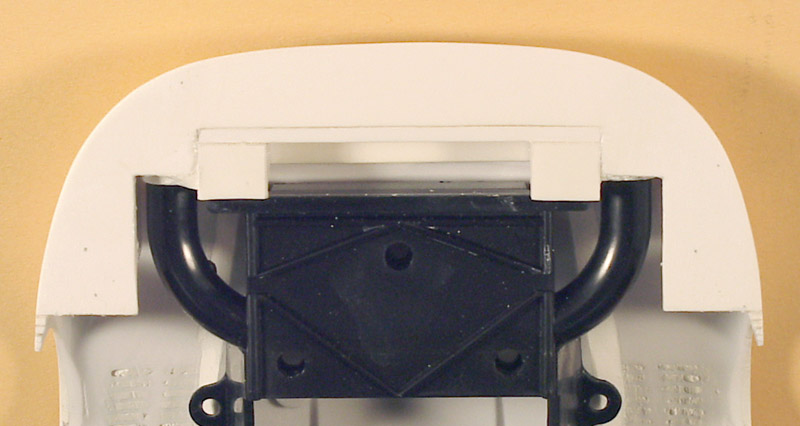
| The downward extension of the nose was achieved by adding a 1 mm piece of card under the Tamiya bodywork. I will call it a splitter plate for the moment. I traced the original contour with a pencil on the plastic card, and cut it out. The inner part was largely removed, leaving just a lip for the front air intake, and lower sides for the headlights. I was about to glue the splitter plate to the bodywork, when I realised that I had overlooked something. The area between the headlights and the air intake was too steep. Therefore the splitter plate had to move forward, by an unknown amount. I superglued a piece of strip on the rear edge of the wheel opening, to serve as a stop, and to ensure alignment of the splitter plate. I had to add one more piece of strip (making a total of 2 mm) before the splitter had moved forward enough. After cutting out the air intake's lower lip (see next paragraph), I superglued it in place. The forward movement made the splitter plate stick out from under the bodywork, so some sanding on the side was necessary to make it flush again.
|
| After deciding for a downward extension of the bodywork, the effects on the front air intake were studied. The kit's lower lip had to go, otherwise a way too thick lip would result. This would increase the intake's height considerably. It turned out the upper lip was too thin in its current form, the real car has a Dunlop sticker applied there, and this wouldn't fit on the model. Therefore a 1 mm thick piece of card was superglued to the upper lip. The air intake has two inset air intakes, and from photos I decided to make the radiator 30 mm wide. Two vertical pieces of card were superglued in place to divide the air intake. Lastly, the curvature of the lower lip was reduced. Compared to the 935-78, the K4 has a less curved lip.
| 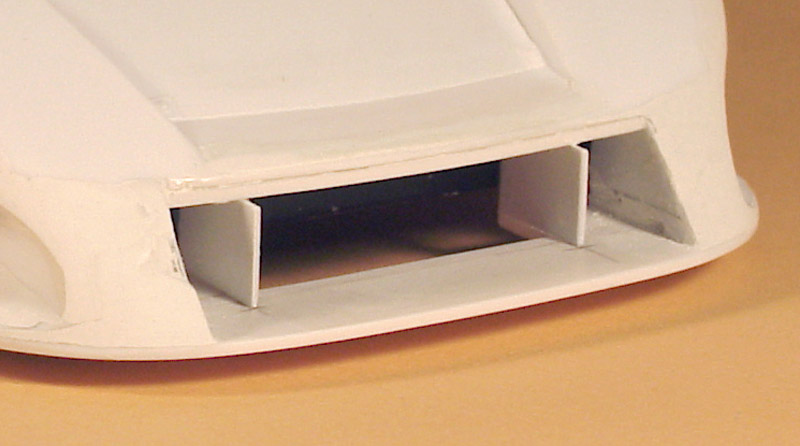
|
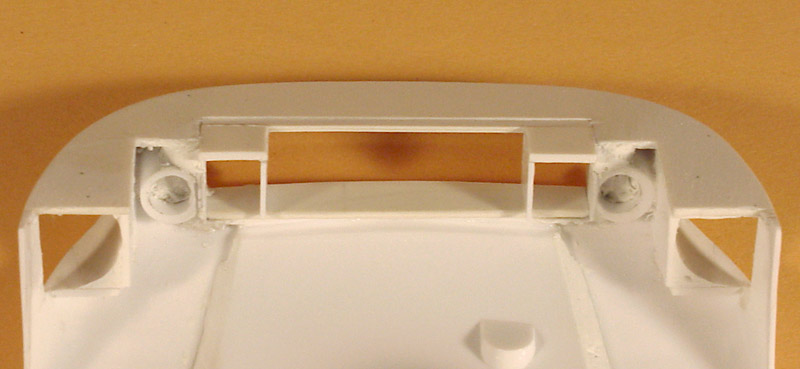
| And this is how it now looks on the inside.
|
Construction - front cover
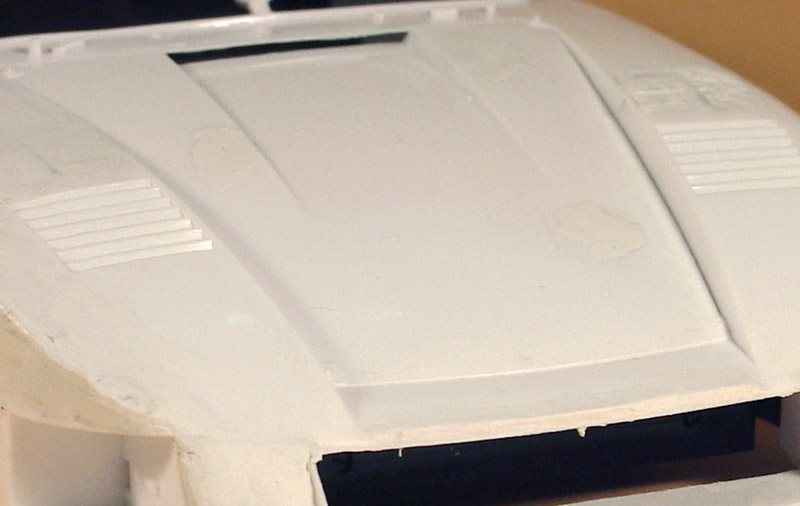
| Vaguely visible here is the Milliput to fill three filler openings in the hood (not yet sanded). The small step in the upper lip of the air intake was filled. After consulting new documents, it seems I was a bit too quick here. The openings are actually covered by lids, that should be engraved.
|
| Another modification is the chamfering of the inside edges of the fenders, shown here only on the cars right hand side. I guess they are at a 40 degree angle. The plastic is reduced to a very thin section, and I added Milliput to the inside. The chamfering eats away part of the forward louvres. These will move outboard later.
| 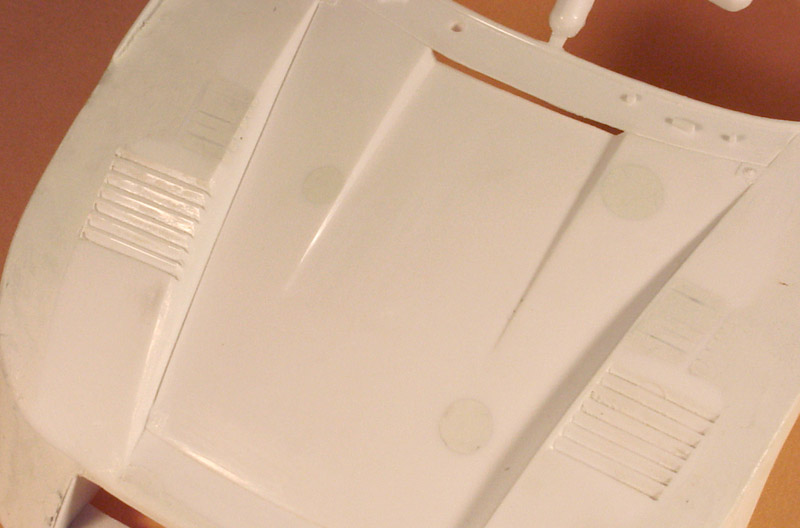
|
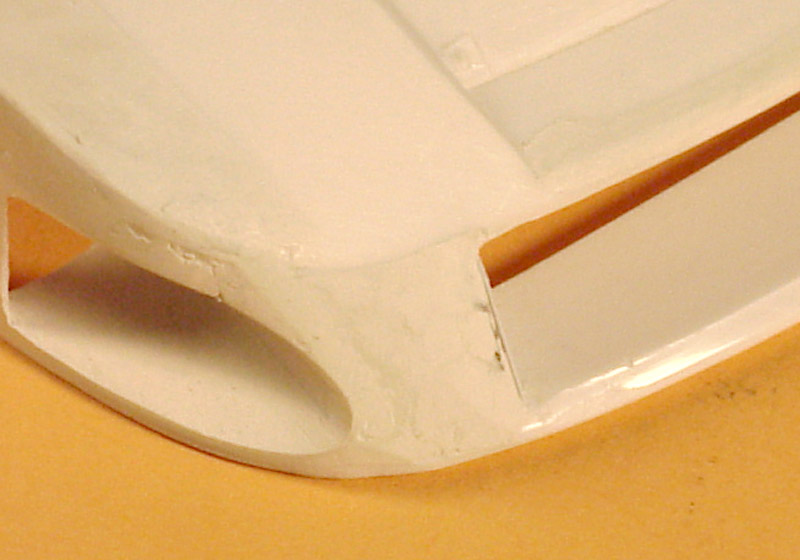
| The Kremer K4 does not have a separate splitter under the nose bodywork. Rather the bodywork itself has a small forward extension. Since the 935-78 lip projects from under the body, it had to go. I removed it completely, so the body now has a more or less flat lower side.
|
Construction - headlights
| The most complicated issue of the front end are the headlights. Instead of the rectangular units of the 935-78, the K4 has sort-of elliptical headlights. Fellow GPMA member Dale King suggested a technique that worked very well: by removing the rear face of the headlight tunnel, rat tail files could be used to shape the new tunnels. After removal of the rear face, it became clear that the resulting tunnel was also too low. Therefore the lower face also had to go. I removed it using a saw and cutters, and superglued a new face on the remains. It lies flush with the lower side of the car. Later it turned out that the rat files would also take away some of the top face. As a precaution, some card was roughly glued on top of the top face (bottom of the photo).
| 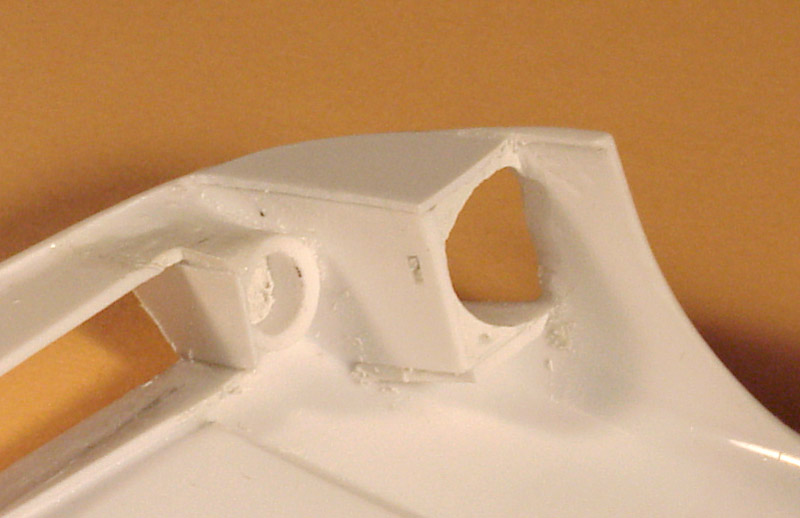
|
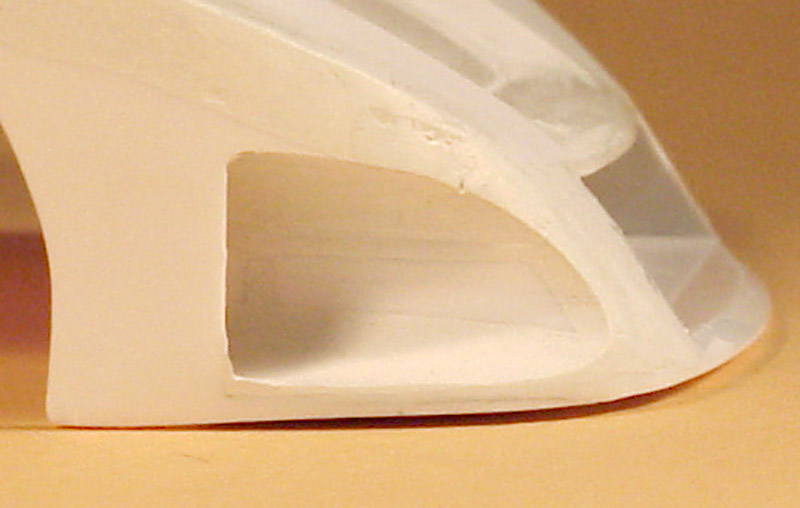
| Then it was Milliput time again. A lot of it was smeared in the headlight tunnel. After yet another oven cure at 50 degrees C I started sanding and filing. With a set of photos for comparison I tried to achieve the correct shape. What you see below it the first attempt that still needs modification. The photo also shows that the nose is still too steep.
|
| A big problem was that the photos clearly showed that the rear half of the headlight cover stood vertically. Yet the opening did not allow this at all. After studying the photos some more I decided to modify the planform of the nose, and cut away part of the lower edge of the headlight area. It is now getting close to the desired shape.
| 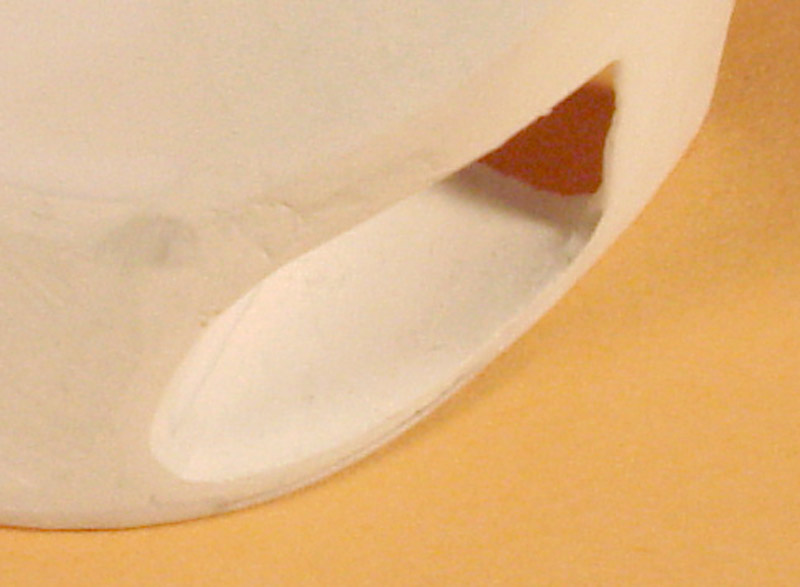
|
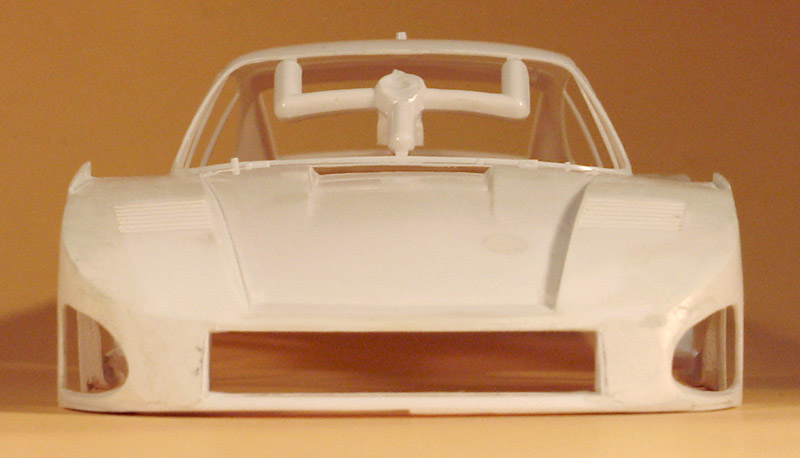
| All this leads to the following rough nose shape.
|
| Judging from photos, my headlights were still too small. With the extended bodywork, the headlights should be extended downwards. About 1 mm was removed by sanding. Also, the headlight was extended rearwards by some 2 mm. The forward upper contour of the headlight is still too large however. Another modification made to the body was a slight outward and downward sloping of the fenders. The fenders already had this slope near the windshield, but not at the front end. Sanding solved that problem. Now a new judging round is necessary.
| 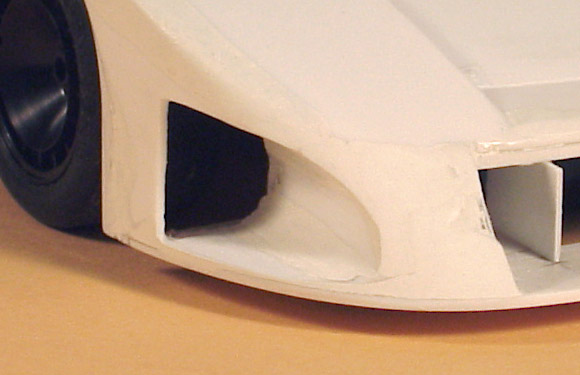
|
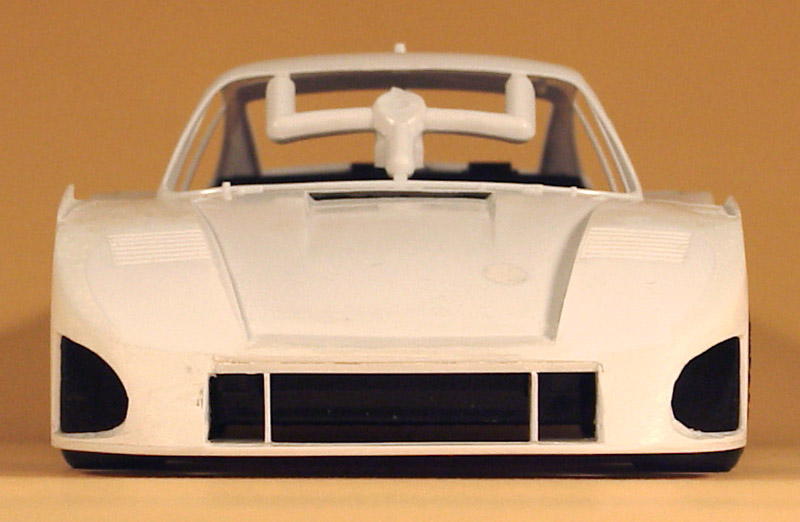
| The headlight and air intake modifications now lead the following preliminary front view.
|
Construction - stance
| I have a strong feeling that something is wrong with the model's ride height, which is some 4.5 to 5 mm. And if that is true, how should it dealt be with? The wheels can hardly be positioned higher in the fenders, they are partially covered by the fenders already. Alternatively, the body should be extended on the lower side. This in turn messes up the position of the headlights, and the front air intake. Concluding, it is a serious issue.
| 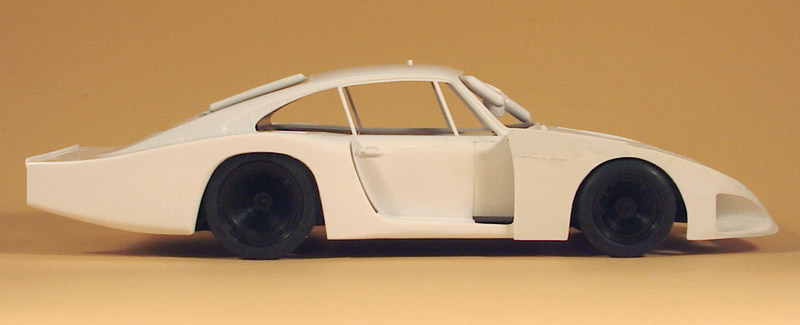
|
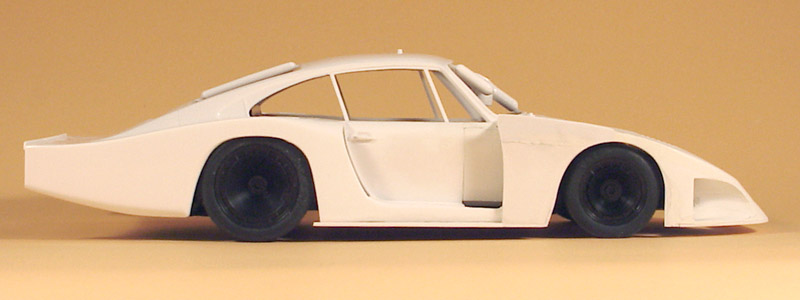
| Moving to the end result for a moment, this photo shows the ride height after modifications. It's about 3 mm now, with 2 mm being the goal. But it will be tough to find that extra millimeter.
|
| Working from the axle position of the Tamiya chassis, the front tire should be completely visible on the K4. Therefore I sanded the opening a little higher. I think the wheel opening could be sanded still a little higher, which would then allow the chassis to be dropped a little.
| 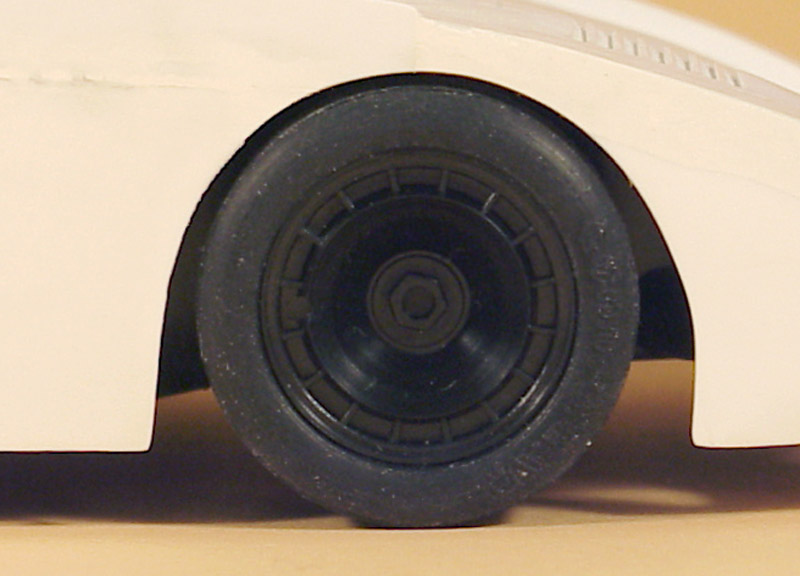
|
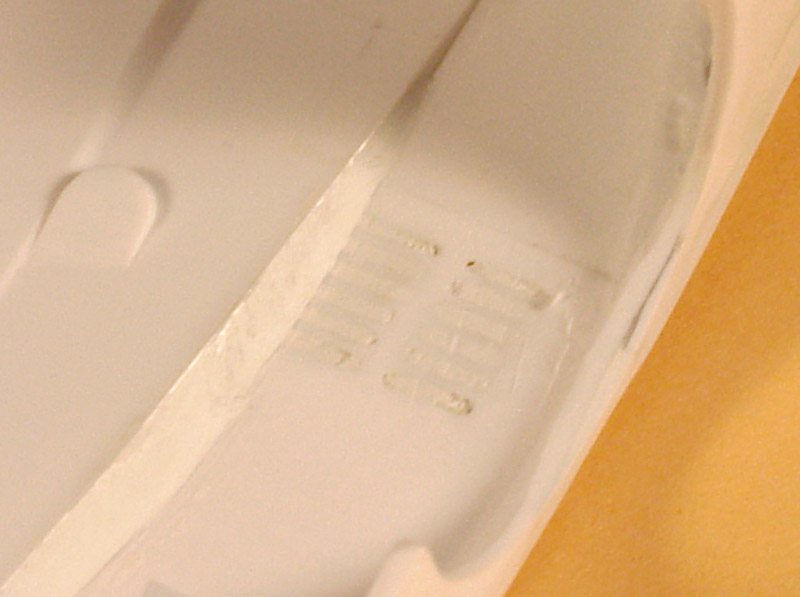
| The photo below vaguely shows the sanded upper edge of the wheel opening.
|
| The wheel opening had to be modified for a K4. The front edge was built up with strip styrene until the right shape was achieved. A start was made modifying the rear edge, but it must be modified a lot more before the correct shape is found.
| 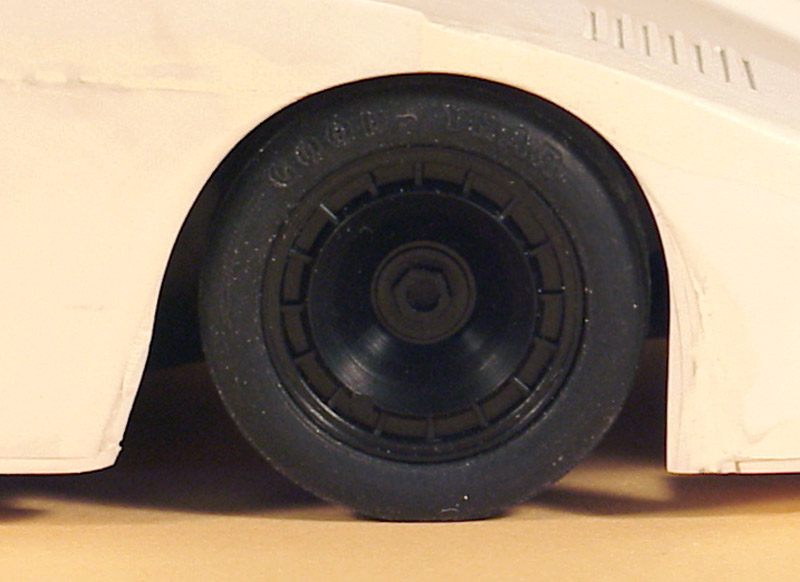
|
Construction - skirts
| Although I had worked strictly on the nose section so far, I decided to add 1 mm plastic card to the center body too, in order to judge the progress on the ride height. The strips were glued in place using a ruler held against both front and rear fenders. I think some more modifications are required, since the running board is almost parallel with the door now. The real car shows some widening to the rear. One solution is to widen the rear fenders. Judging from photos, this appears to be a correct modification. Something for later.
| 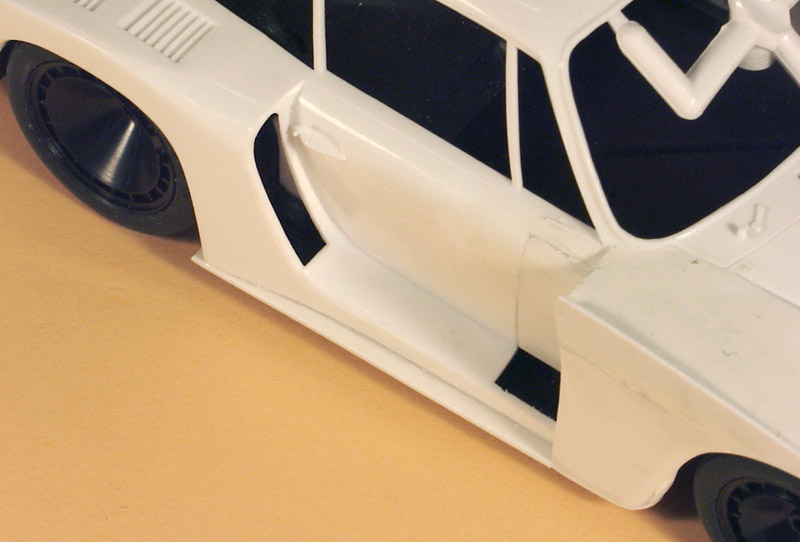
|
Wheels and tires
In photos I see two types of wheels used on the Kremer Jagermeister car: BBS wheels and unknown wheels with some sort of 'Lüfterräder' fitted, discs with radial fins to promote brake cooling I think. These disks are black with gold stripes in a pattern similar to BBS spokes, so it is not unlikely that the wheels behind them are BBS too. I don't like the discs much, so I plan to use 'plain' BBS wheels. The wheels in the 935-78 kit are not very nice, they have similar discs cast integrally with the wheels.
I did some provisional measurements on the wheels, using K4 photos, and came up with 16" fronts and 19" rears. More checking is required though! The Tamiya 935-78 wheels are 16" fronts and 19" rears (1.6" was deducted from the measurements, to account for the tire retaining lip). The 16" BBS front wheels of the Tamiya 956 fit nicely in the 935-78 tire. 18" BBS wheels from Perry's Resin are too small for the Tamiya 935-78 rear tires, as could be expected. Possibly the Hasegawa 962 (CC-14) has 19" BBS wheels. I must consult some Porsche books from the library to find out what wheels were specified for the 935-78. The disc of the K4's rear wheel sits much deeper inside the rim, compared to BBS wheels for Porsche 956/962's.
Decals
Early 2003 I learned how to make decal artwork with vector graphics (CorelDraw in my case). On the left you can see the stepwise generation of the Jagermeister text. I downloaded a black version from the fantastic Russian logo site. I first changed the text to white. Next step was adding a narrow black edge, and the last step was a small extrusion to the right. I now had the Jagermeister text that I saw in photos of the real K4. I could then copy the logo in several sizes, and create the artwork for an Alps printer. The hippy door number is based on the Clarendon CnBT font but heavily modified. The other sponser logos were also found on the Russian logo site, but most had to be modified. The 'DP' and 'KKK' decals are home-made; the former was designed freehand, the latter drawn over a decal of the Tamiya 1/12 935. DP Motorsport (DP is short for Design Plastic) is a company that developped and built (among others) the K3 bodywork, and possibly the K4 bodywork too. Saving the best for last, I'm still working on the Jagermeister logo with the deer head. These are also the only color decals on this car. An alternative to Alps decals could be this Museum Collection decal sheet (DC-195) for a regular Porsche 935.
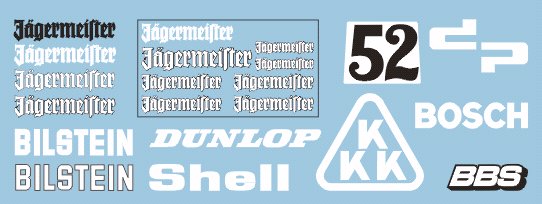
Studio 27 issued sheet DC-1227 for the 1980-1981 season Porsche 935 K3 in the DRM championship. This sheet probably has lots of suitable decals for the K4.
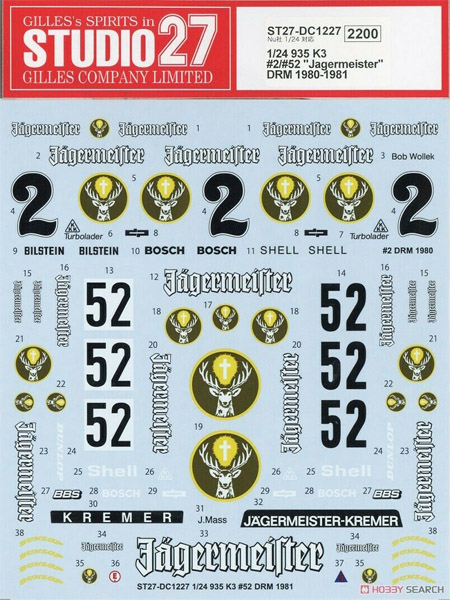
Histories of K4-01 and K4-02
The Jägermeister car that I want to portray is K4-001. The race histories of both cars are based on Porsche chassis numbers listings on the Classic Cars site, checked, corrected and extended with more data, particularly with the fantastic
Racing Sports Cars Photo Archive. The K4 is not always easy to distinguish from other radical 935's. For example, the mold of the K4 nose was also used for Akin's 935-84. One unique recognition point is that the K4 has (turbo) inlets in the rear pillar.
K4-01
Right-hand drive, always remained so.
During Fitzpatrick ownership modified by Robin Herd with larger rear wing, ground effects skirts, front radiator outlet duct on the front lid, and full width doors. Oldest photo found so far with full-width doors is 23 May 1982, i.e. one of the first American races.
|
1981, Kremer, Jägermeister sponsoring, #52
|
| 21 June
| Wunstorf
| Wollek
| 5th
| Possibly was a K3 instead of K4. Racing Sports Cars site says K4
|
| 28 June
| Norisring Trophäe
| Wollek
| 6th in 1st heat, 1st in 2nd heat
|
| 5 July
| GP von Tourenwagen Nurburgring
| Wollek
| 1st
|
| 12 July
| ADAC Bavaria Rennen Salzburgring
| Wollek
| 2nd
|
| 1 August
| AvD Gold Pokal Hockenheim
| Wollek
| DNF
|
| 23 August
| Westfalen-Pokal Zolder
| Wollek
| 2nd
|
| 6 September
| Hessen-cup Hockenheim
| Wollek
| 2nd
|
| 20 September
| ADAC-Bilstein Super Sprint Nurburgring
| Wollek
| 2nd
|
1982, Fitzpatrick Racing, #2, JDavid/Golden Eagle sponsor scheme
|
| 31 January
| Daytona 24 Hours
| Fitzpatrick/Hobbs
| DNF, 19th GTP/GTX
| Not correct, was a K3 !!
|
| 20 March
| Sebring 12 Hours
| Fitzpatrick/Hobbs
| DNF, 22nd GTP/GTX
| Not correct, was a K3 !!
|
| 4 April
| Road America 150 miles
| Fitzpatrick
| DNS ?
|
| 25 April
| Riverside 6 Hours
| Fitzpatrick
| DNF, 9th GTP/GTX
| Listed as a K4
|
| 2 May
| Laguna Seca 100 miles
| Fitzpatrick
| 3rd
|
| 16 May
| 6 Hours Silverstone
| Fitzpatrick
| listed as DNS, but I think I saw it in a video. Listed as #79
|
| 23 May
| Mid Ohio 100 miles
| Fitzpatrick
| 1st
| Photo confirms K4
|
| 31 May
| Lime Rock 1 Hour
| Fitzpatrick
| 1st
|
| 11 July
| Brainerd 200 kilometer
| Fitzpatrick
| 6th *
|
| 25 July
| Sears Point 100 miles
| Fitzpatrick
| 4th *
|
| 1 August
| Portland 100 miles
| Fitzpatrick
| 7th *
|
| 22 August
| Road America / Elkhart Lake 500 miles
| Fitzpatrick/Hobbs
| 1st *
|
| 5 September
| Mid Ohio
| Fitzpatrick
| 1st *
|
| 12 September ??
| Road Atlanta
| 6 Hours
| ??
|
| 17 October
| Brands Hatch 1000 Km
| Fitzpatrick/Hobbs/Wollek
| 3rd OA, 1st in IMSA class, raced as #22
|
| 28 November
| Daytona Finale
| Fitzpatrick/Wollek
| 2nd
|
1983, Fitzpatrick Racing, #2, JDavid sponsor scheme
|
| 27 February
| Miami GP
| Fitzpatrick
| 4th
|
| 24 April
| Riverside 6 Hours
| Fitzpatrick/Bell/Hobbs
| 1st
|
| 31 July
| Portland
| Fitzpatrick
|
|
| likely more races
|
|
|
|
1984, rented to Holbert, Lowenbrau colors, #14
|
| 26 Februari
| GP of Miami
| Holbert
| DNF
|
| 24 March
| 12 Hours Sebring
| Graham/Gralia/Henn/Wollek/Holbert
| 6th OA
|
| 8 April
| 500 km Road Atlanta
| Holbert/Bell
| 50th
|
1986
|
| Sold by Fitzpatrick to Mike Hagen, in Löwenbrau colors
|
19..
|
| Sold to De Vries
|
2004
|
| Sold to Wonder
|
K4-02 history
Built as right-hand drive, but modified on request to left-hand drive before being sold to Ted Field.
There is lots of confusion about the 1981 and 1982 seasons regarding the Interscope car. On different webpages about the 1981 races it is listed as a K3, K3/80 or K4. Race photos are needed to establish the truth. The confusion is probably the result of the team's qualifying method: they brought a trailer full of cars, tested all of them, and the slowest were withdrawn for the race. It appears the K4 was part of that trailer full of cars, but it usually was seconds slower than the K3, and hence raced possibly only once, or never. Therefore, consider the table below as provisional!
The post-race history is equally unclear. Apart from the owners listed below, the following owners are also reported: sold to Michae l Lauer, race prepped by Gunnar Racing, sold to Marshall Field. Possibly it all fits in the data below, but I don't know where and how.
|
1981, Interscope, #0
|
| 31 January
| 24 Hours Daytona
| Field/Minter/Ongais
| DNF
| Photos show #0 to be a K3, #00 reported as K3/80
|
| 21 March
| 12 Hours Sebring
| Field/Ongais
| DNS
| #0 reported as a K3, #00 reported as K3/80
|
|
| 6 Hours Riverside
| Field/Ongais
| DNF
|
|
| 6 Hours Watkins Glen
| Field/Whittington
| DNF
|
| 16 August
| Mosport
| Field/Whittington
| 3rd
| #0 reported as a K3, #00 reported as K3/80
|
|
| Elkhart Lake
| Field/Whittington
| 7th
|
1982, Interscope, #00
|
|
| 24 Hours Daytona
| Field
| DNF
|
| 20 March
| 12 Hours Sebring
| Field/Ongais
| DNS
|
|
| Mosport
| Field/Ongais
| 3rd
|
|
19..
|
| Sold Vasek Polak Museum
|
1998
|
| No engine, possibly used in the Akin 935-84 for a number of years already.
|
19../20..
|
| Sold by Polak
|
2001/2002
|
| Restored during the winter. The chassis was strengthened with nomex honeycomb panels. A new 3.2 litre twin turbo motor from Porsche Motorsport was installed. Shocks replaced with Penske 3 way adjustable. Spares included extra set of 18" wheels plus sets sets of 16" wheels, all the original gauges and dash layout, mold for nose, and some spare gears.
|
2002
|
| For sale on the Classic Car Collection site
|
I received a interesting e-mail from Mike Hagen that I have to show here:
The K4 was a Kremer copy of the Moby Dick car with major improvements. The Porsche factory was building 956's and did not want to build 935. They had a few orders for the 935, so they gave the drawings, the Moby Dick car and parts on commision to Kremer to fabicate two 935s. These were 935K4 001 (left hand steering) and 935K4 02 (right hand steering).
I bought 935K4 001 from John [Fitzpatrick] about 1986. 935K4 001 was rented to Holbert by Fitz for the last IMSA race at Atlanta. Since Holbert was sponsored by Lowenbrau and Atlanta was the last IMSA race for the car I got the car in Lowenbrau colors. The K4 evolved alot when it came to Fitz. They put 1mil $ into the suspension and bottom (aero belly) before it handled right. I traded the 935 for the 1970 6th place Le Mans 914-6 GT and the 1982 Le Mans BFG 924 GTR.
Akin's car was built by Klym and was one of the very last 935s built anywhere. The front and doors were splashed off of the 935K4 001 car molds with a different rear end.
Modeling links
Return to models page






























